Page 57 of 95
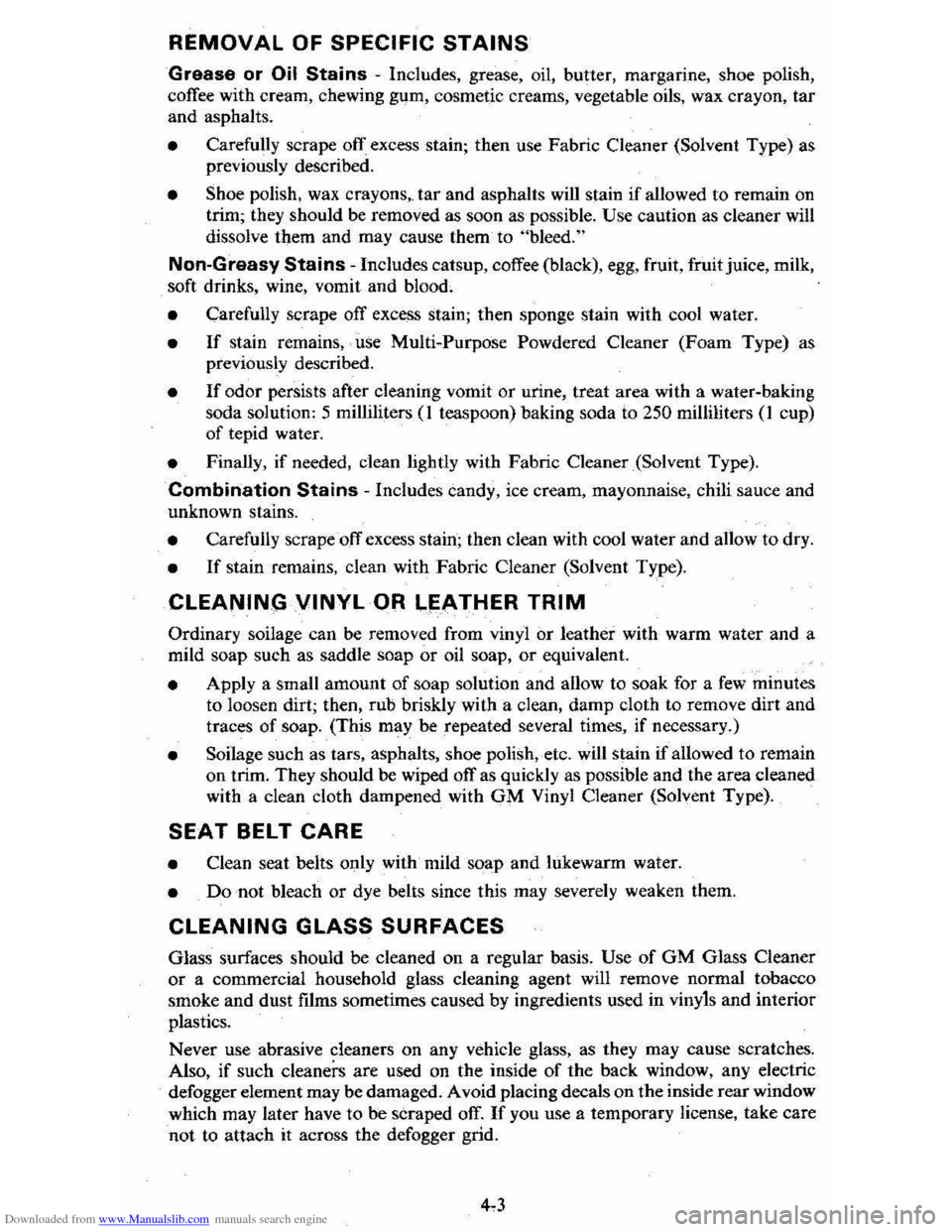
Downloaded from www.Manualslib.com manuals search engine REMOVAL OF SPECIFIC STAINS
Grease or Oil Stains -Includes, grease, oil, butter, margarine, shoe polish,
coffee with cream, chewing gum, cosmetic creams, vegetable oils, wax crayon, tar
and asphalts.
• Carefully scrape of I excess stain; then use Fabric Cleaner (Solvent Type) as
previously described.
• Shoe polish, wax crayons,. tar and asphalts will stain if allowed to remain on
trim; they should be removed as soon as possible. Use caution as cleaner will
dissolve them and may cause them to "bleed."
Non-Greasy Stains -Includes catsup, coffee (black), egg, fruit, fruit juice, milk,
soft drinks, wine, vomit and blood;
•
Carefully scrape off excess stain; then sponge stain with cool water.
• If stain remains,"· use Multi-Purpose Powdered Cleaner (Foam Type) as
previously described.
• If odor persists after cleaning vomit or urine, treat area with a water-baking
soda solution: 5 milliliters (1 teaspoon) baking soda to 250 milliliters (1 cup)
of tepid water.
• Finally, if needed, clean lightly with Fabric Cleaner (Solvent Type).
Combination
Stains - Includes candy, ice cream, mayonnaise , chili sauce and
unknown stains.
• Carefully scrape off excess stain; then clean with cool water and allow to dry.
• If stain remains, clean with Fabric Cleaner (Solvent Type).
CLEANING VINYL OR LEATHER TRIM
Ordinary soilage can be removed from vinyl or leather with warm water and a
mild soap such as saddle soap or oil soap, or equivalent.
• Apply a small amount of soap solution and allow to soak for a few minutes
to loosen dirt; then, rub briskly with a clean, damp cloth to remove dirt and
traces of soap. (This may be repeated several times,
if necessary.)
• Soilage such as tars, asphalts, shoe polish,etc. will stain if allowed to remain
on trim. They should be wiped ofT as quickly as possible and the area cleaned
with a clean cloth dampened with GM Vinyl Cleaner (Solvent Type).
SEAT BELT CARE
• Clean seat belts only with mild soap and lukewarm water.
• Do not bleach or dye belts since this may severely weaken them.
CLEANING GLASS SURFACES
Glass surfaces should be cleaned on a regular basis. Use of GM Glass Cleaner or a commercial household glass cleaning agent will remove normal tobacco
smoke and dust films sometimes caused by ingredients used in vinyls and interior
plastics.
Never use abrasive cleaners on any vehicle glass, as they may cause scratches.
Also,
if such cleaners are used on the inside of the back window, any electric
defogger element may be damaged. A void placing decals on the inside rear window
which may later have to be scraped
ofT. If you use a temporary license, take care
not to attach it across the defogger grid.
Page 58 of 95
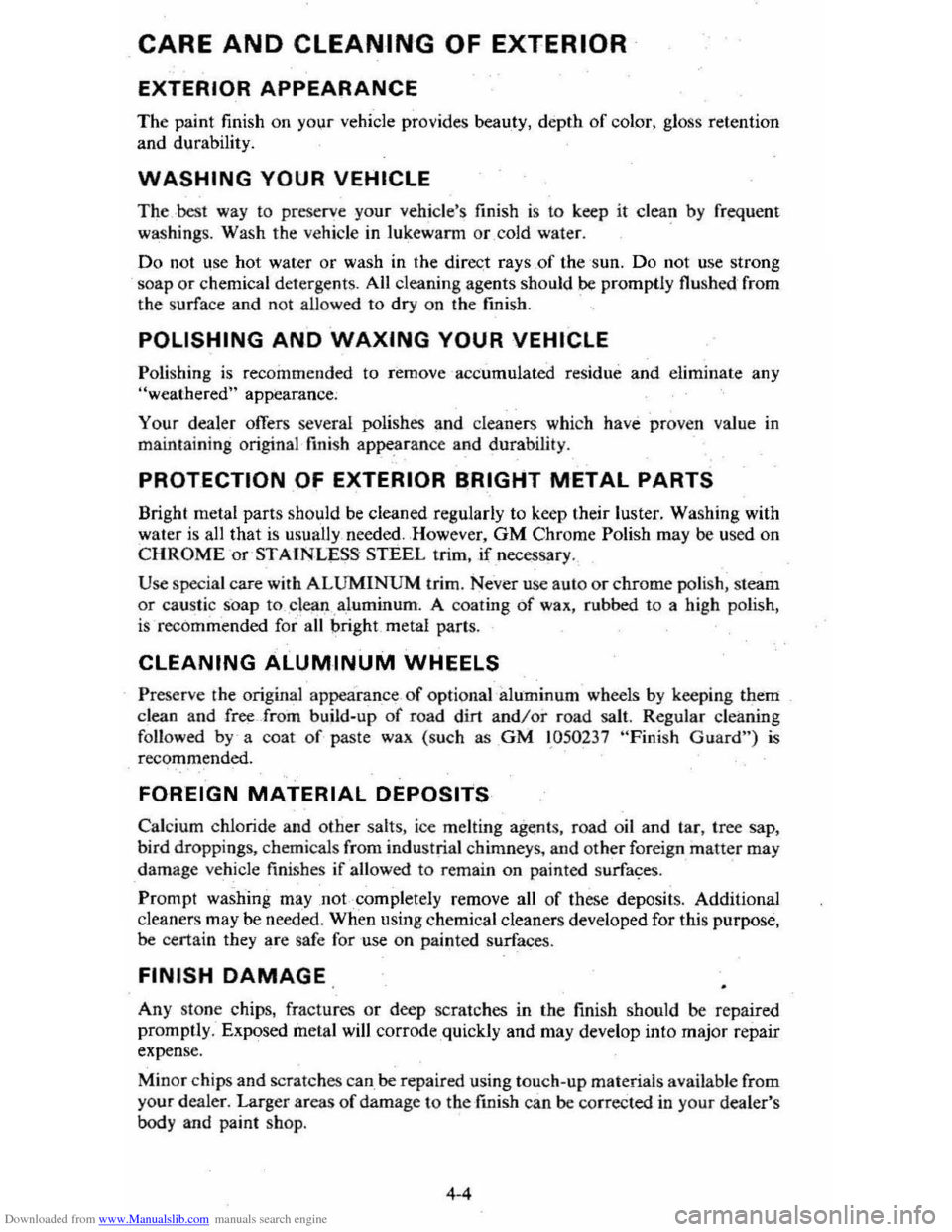
Downloaded from www.Manualslib.com manuals search engine CARE AND CLEANING OF EXTERIOR
EXTERIOR APPEARANCE
The paint finish on yo~r vehicle provides beauty, depth of color, gloss retention
and durability.
WASHING YOUR VEHICLE
The best way to preserve your vehicle's finish is to keep it clean by frequent
wa sh ings. Wash the vehicle in lukewarm or cold wate r. .
Do n o t lise hot water or wash in the direct rays of the 's un. Do not use stro ng
soap or chemical deterge nts. All cleaning agents should be promptly flushed from the surface and not allowed to dry on the fini sh .
POLISHING AND WAXING YOUR VEHICLE
Poli shin g is recomme nded to rem ove accu mulat ed residue and elim inate any "weathered" appearance;
Y ou r dealer offers several
polishes and cleaners which have proven value in
m aint
ainin g original finish appe .a rance and durability .
PROTECTION OF EXTERIOR ~RIGHT METAL PARTS
Bright metal parts should be clean ed regu larly to keep their luster. Washing with
wat er i s all that
is usu ally, needed. How ever, GM Chrome Polish may be used on CHROME or STAINLESS STEEL trim. if neces sary .
Use spec ial care with ALUMINU M trim . N eve r use aul a o r chrome polish, s team
or caustic soap to clean .aluminum. A coat ing of wax, rubbed to a high polish,
is recom mended for all bright metal parts.
CLEANING ALUMINUM WHEELS
Prese rve the original appearance of opti onal ·aluminum wheels by keep ing them clean and free ·Jrorn build-up of road dirt andlor road salt. Regular cleaning
followed
by · a coat of paste wax (such as GM 1.050237 " Fini sh Guard") is reco mm ended.
FOREIGN MATERIAL DEPOSITS
Calcium chloride and other salts, ice melt ing ag~nts, road oil and tar, tree sap ,
bird drop pings , chem icals from industria l c himn eys, and other foreign matter may
dam age
vehicle finishe s if allowed to remai n on painted surfa~es.
Promp t washing may ,not complet ely remove all of these deposits. Additional
clean ers may be needed . When using chem ical clean ers developed for this purpose,
be certain they are safe for use on painted s
urfaces.
FINISH DAMAGE.
Any sto ne chips, fractures or deep scratches in the finish should be repaired
promptly. Exposed
meta l will corrode ,quick ly and may develo p into majo r repair
exp ense.
Min or chips and scratches c
an be repaired using touc h-up materials available from
your dealer. Larger areas of dama ge to the finish can be co rreeted in your dealer's
body and paint sho p.
4 -4
Page 59 of 95
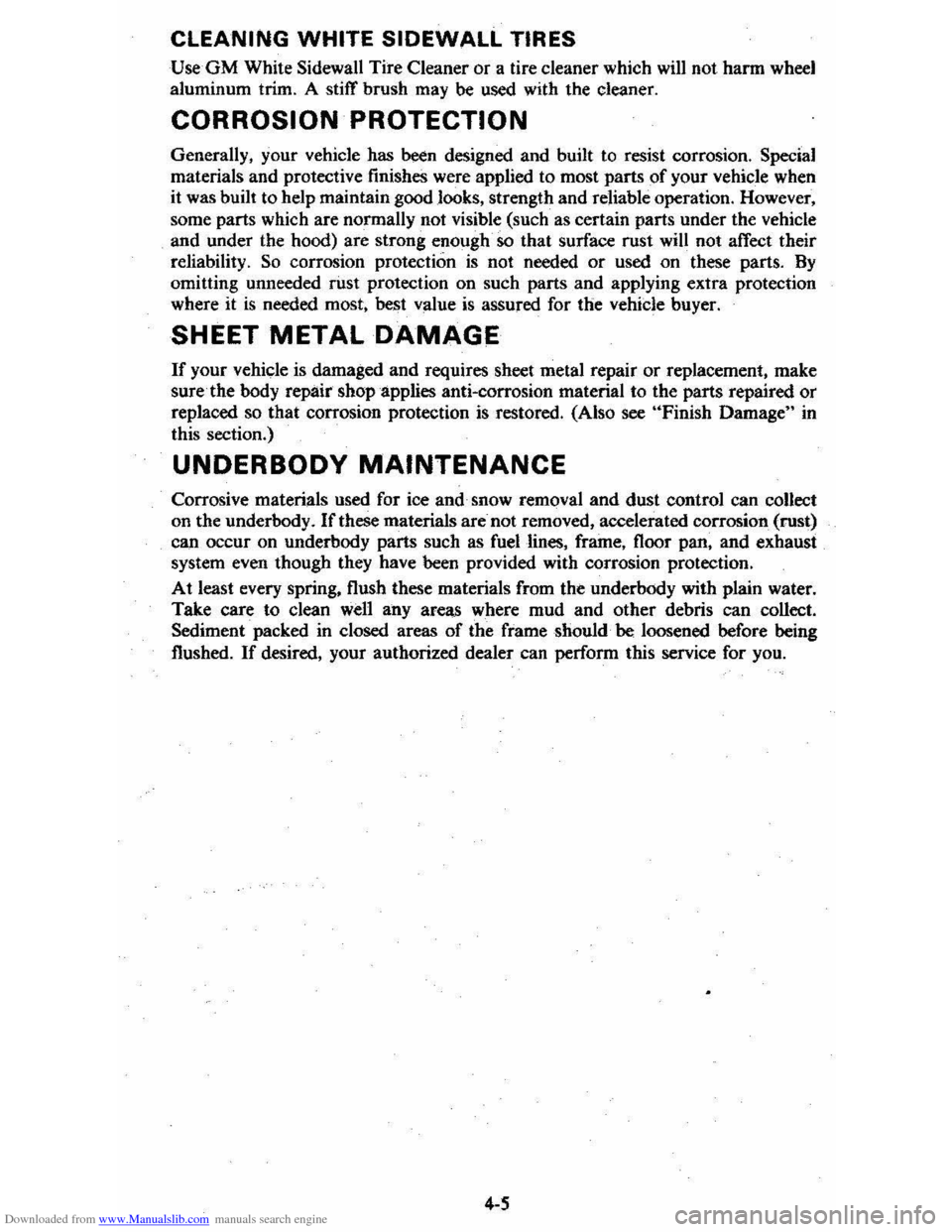
Downloaded from www.Manualslib.com manuals search engine CLEANING WHITE SIDEWALL TIRES
UseGM White Sidewall Tire Cleaner or a tire cleaner which will not harm wheel
aluminum trim. A stitT brush may
be used with the cleaner.
CORROSION PROTECTION
Generally, your vehicle has been designed and built to resist corrosion. Special
materials and protective finishes were applied to most parts of your vehicle when it was built to belp maintain good looks, strength and reliable operation. However,
some parts which are normally not visible (such as certain parts
under the vehicle and under the hood) are strong enough so that surface rust will not affect their
reliability.
So corrosion protection is not needed or used on these parts. By
omitting unneeded fust protection on such parts and applying extra protection where it is needed most, best value is assured for the vehicle buyer.
SHEET METAL DAMAGE
If your vehicle is damaged and requires sheet metal repair or replacement. make
sure·
the body repair shop applies anti-corrosion material to the parts repaired or replaced so that corrosion protection is restored. (Also see "Finish Damage" in
this section.)
UNDERBODY MAINTENANCE
Corrosive materials used for ice and· snow removal and dust control can collect
on the underbody. If these materials are-not removed. accelerated corrosion (rust)
can
occur on underbody parts such as fuel lines. frame, floor pan. and exhaust
system even though they have been provided with corrosion protection.
At least every spring. flush these materials from the underbooy with plain water.
Take care to clean well any areas where mud and other debris can collect.
Sediment packed in closed areas
of the frame should . be loosened before being
flushed.
If desired. your authorized dealer can perform this service for you.
4-5
Page 60 of 95
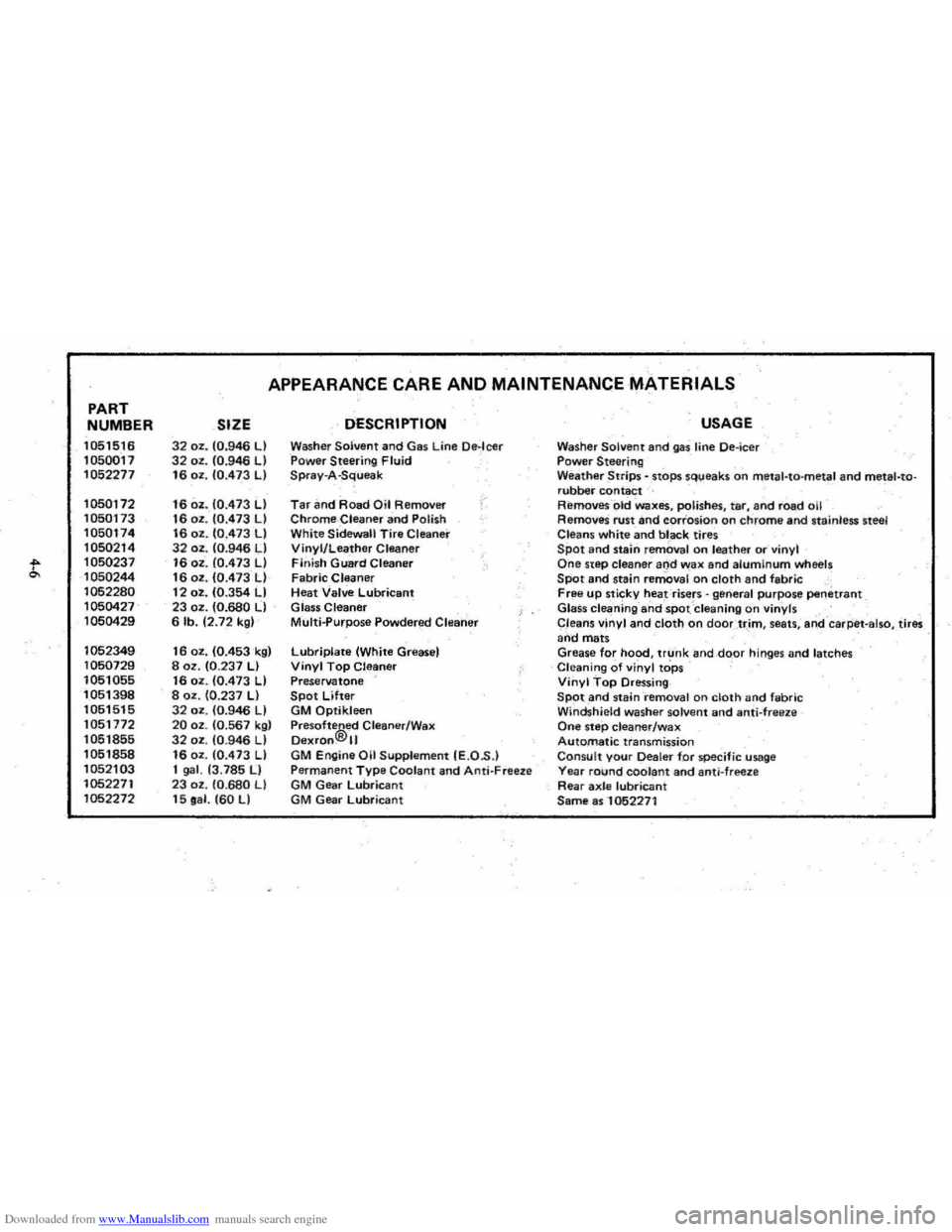
Downloaded from www.Manualslib.com manuals search engine PART
NUMBER
1051516
1050017
1052277
1050172 1050173
1050174
1050214
t 1050237
1050244
1052280
1050427 1050429
1052349
1050729
1051055 1051398 1051515
1051772 1051855
1051858
1052103
1052271 1052272
APPEARANCE CARE AND MAINTENANCE MATERIALS
SIZE DESCRIPTION
32 oz. 10.946 LI Washer Solvent and Gas Line De·leer 32 oz. 10.946 LI Power Steering Fluid 16 oz. 10.473 LI Spray-A-Squeak
16 oz. 10.473 LI Tar an d Road Oil Removirr /"
16 oz . 10.473 LI Chrome-Cleaner and Polish 16 oz. 10.473 LI White Sidewall Tire Cleaner 32 oz. 10:946 LI Vinyl/Leather Cleaner 16 oz . 10.473 LI Finish Guard Cleaner 16 oz. 10.473 LI Fabric Cleaner 12 oz. 10.354 LI Heat Valve Lubricant 23 oz. (0.680 LI Glass Cleaner 6 lb. 12.72 kgl Multi..purpose Powdered Clearier
16 oz. 10.453k91 Lubriplate (White Greasel 8 oz. 10.237 LI Vinyl Top Cleaner 16 oz. 10.473 LI Preservatone 8 oz. 10.237 LI Spot Lifter 32 oz. 10.946 LI GM Qptikleen 20 oz. 10.567 kgl Pre softe®ed Cleaner/Wax 32 oz. 10.946 LI Dexfon. II 16 oz. 10.473 LI GM Engine Oil Supplement IE.O .S .) 1 gal. 13.785 II Permanent Type Coolant and Anti- Freeze 23 oz . 10.680 LI GM Gear lubricant 15 oa l. 160 LI GM Gear Lubricant
USAGE
Washer Solvent and gas line Oe-ieer Power Steering Weather Strips - .stops sq\;leaks on meta l-ta-metal and metal-torubber contact Removes- -old Waxes, polishes, tar, and road oil RemoveS rust and corrosion on chrome and stainless steel
Cleans white and bl _ack tires Spot and stalrl removal o n leather or vinyl One step cleaner and wax and alumInum wh eels SPot and stain removal on cloth and fabric , Free up sticky heat risers -general 'purpose penetrant Glass cleaning ahdspot Cleaning on vinyls
C,leans vinyl and cloth on doortr,im , seats , ari,d -caq:iet -also, tires and mats Grease for hood, trunk and,dQor hinges and latches Cleaning of vinyl tops Vinyl Top Dressing SPOt and staini-emoval on cloth and fabric Windshield washer solvent and anti-freeze One step cleaner/wax Automatic transmission Consult your Dealer for specific usage Yea r round coolant and anti-freez e Rear axle lubricant Same as -1052271
Page 61 of 95
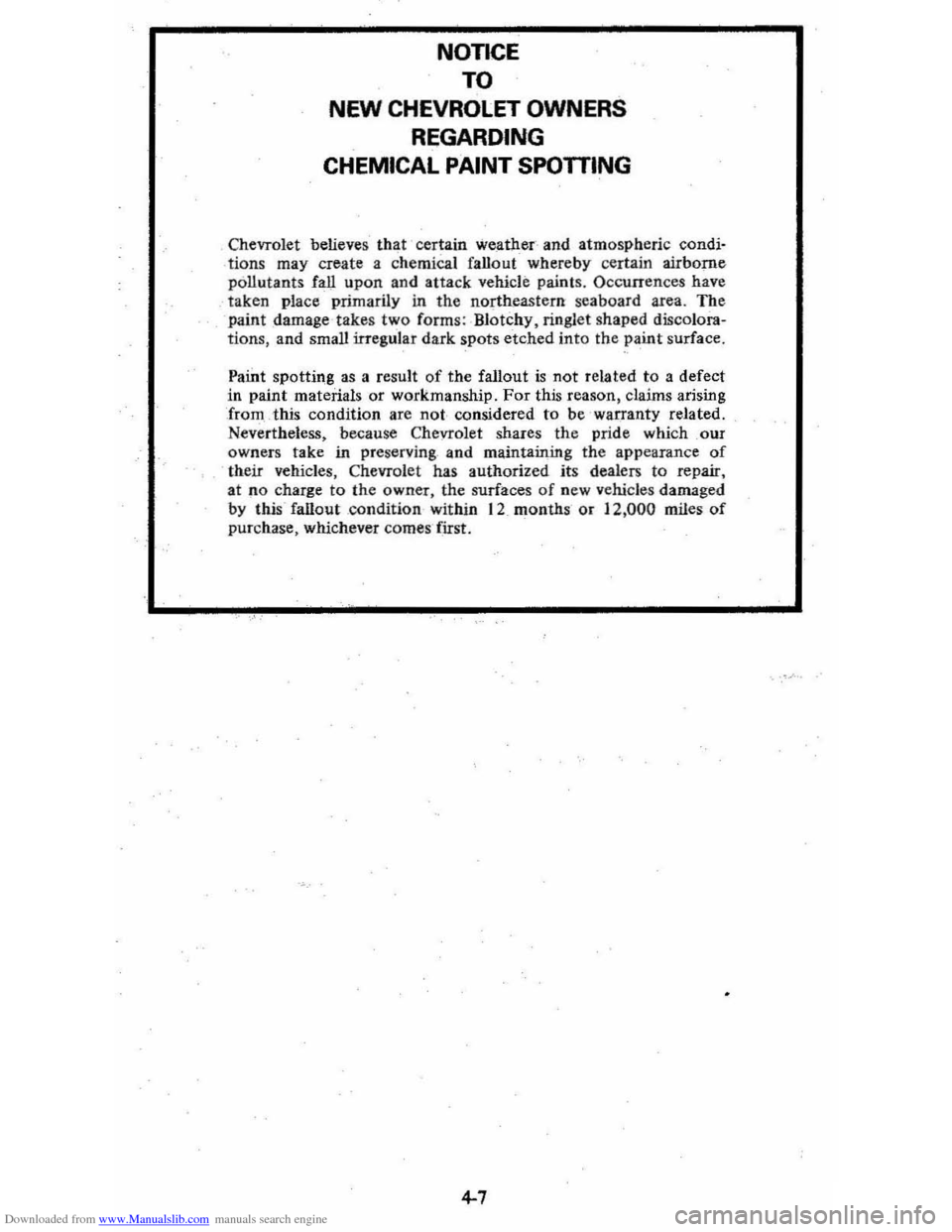
Downloaded from www.Manualslib.com manuals search engine ·.
.
NonCE
TO
NEW CHEVROLET OWNERS
REGARDING
CHEMICAL
PAINT SPOTTING
ChevTOlet believes that certain we_ather and atmospheric condi
tions may create a chemica l fallout whereby certain airborne
pollutants
fall upon and attack vehicle paints. Occurren ces have
taken place primarily in the northeast ern-seaboard area. The paint _damage -takes two forms: -Blotchy . ringl et shaped discolora
tions , and small irregula r dark spots etched into the paint surface.
Paint
spotting as a result of the fallout is not re lated to a defect
in paint material s or workmanship. For this reason, claims arising
from this condition are not co nsidered to be 'warranty related.
Nevertheless, because Chevrolet shares the pride which our owners take in preserving and maintaining the appearance of their vehicles, Chevrol et has authorized its dealers to repair, at no charge [Q the owner, the surfaces of new ve hicl es damaged
by this · faDout condition within 12 . months or 12 ,000 miles of purchase, whichever comes first .
4-7
Page 62 of 95
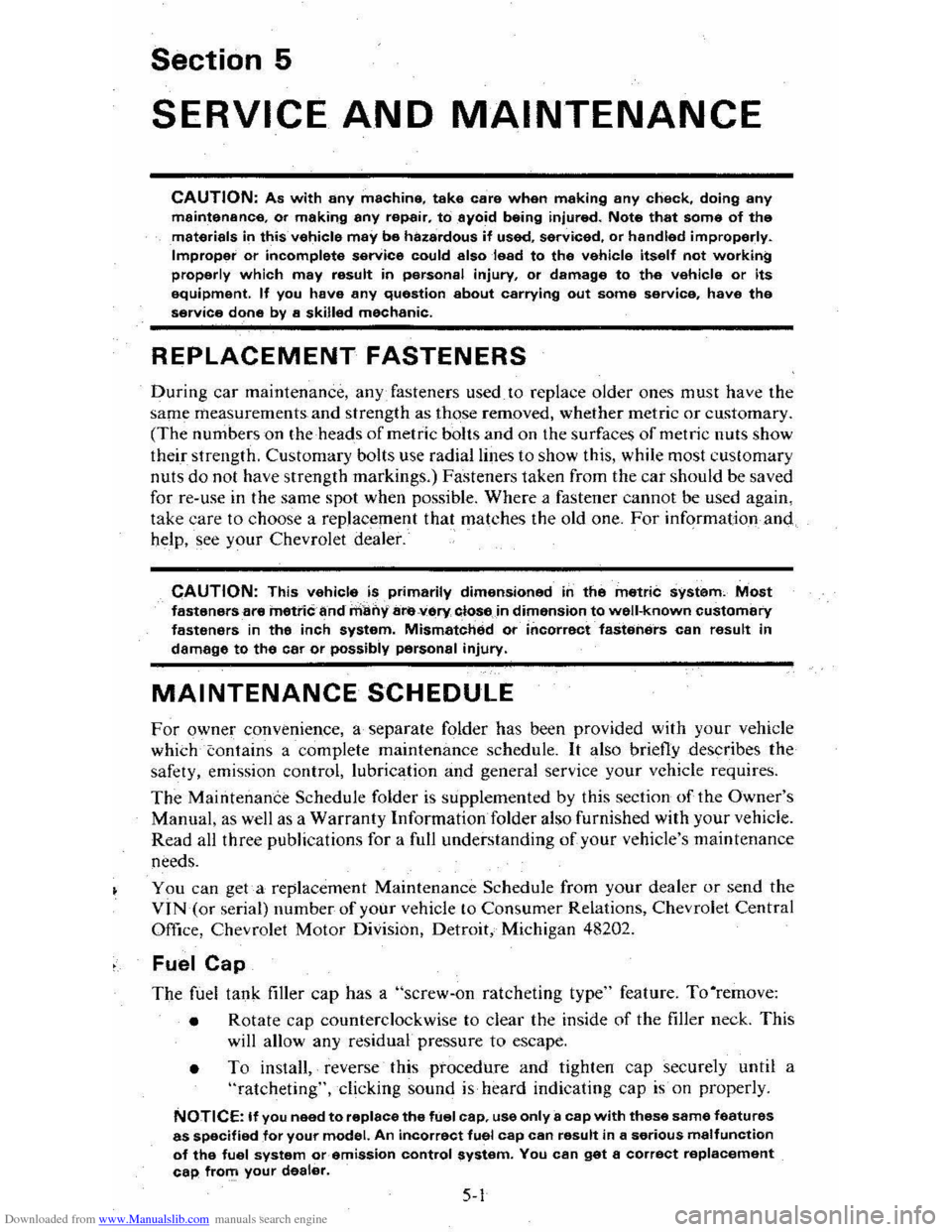
Downloaded from www.Manualslib.com manuals search engine Section 5
SERVICE AND MAINTENANCE
CAUTION: As with any machine, take care when making any check, doing any maintenance. or making any repair. t6ayoid being injured. Note that some of the materials in this vehicle may be hazardous if used, serviced, or handled improperly. Improper or incomplete serVice could also lead to the vehicle itself not working properly which may result in personal injury, or damage to the vehicle or its equipment. If you have any question about carrying out some service, have the service done by 8 skilled mechanic.
REPLACEMENT FASTENERS
During car maintenance, any fasteners used to replace older ones must have the
same measurements and strength as those removed, whether metric or customary. (The numbers on the heads of metric bolts and on the surfaces of metric nuts show
their strength. Customary bolts use radial lines to show this, while most customary
nuts
do not have strength markings.) Fasteners taken from the car should be saved
for re-use in the same spot when possible. Where a fastener cannot be used again,
take care to choose a replacement that matches the old one.
For information and help, see your Chevrolet dealer.
CAUTION: This vehicle is primarily dimensioned in the metric system, Most fasteners are i'neti'icand many lire vary closein dimension to well-known customary fasteners in the inch system. Mismatched or incorrect fasteners can result in damage to the car or possibly personal injury.
MAINTENANCE SCHEDULE
For owner convenience , a separate folder has been provided with your vehicle
which contains a complete maintenance schedule. It also briefly describes the
safety, emission control, lubrication and general service your vehicle requires.
The Maintenance Schedule folder is supplemented by this section of the Owner's
Manual, as well as a Warranty Information folder also furnished with your vehicle.
Read all three publications for a full understanding
of your vehicle's maintenance
needs.
You can get a replacement Maintenance Schedule from your dealer or send the VIN(or serial) number of your vehicle to Consumer Relations, Chevrolet Central
Office, Chevrolet Motor Division, Detroit, Michigan 48202.
Fuel Cap
The fuel tank filler cap has a "screw-on ratcheting type" feature. To·remove:
•
Rotate cap counterclockwise to clear the inside of the filler neck. This
will allow any residual pressure
to escape.
• To install, reverse this procedure and tighten cap securely until a "ratcheting", clicking sound is heard indicating cap is on properly.
NOTICE: If you need to replace the fuel cap, use only a cap with these same features as specified for your model. An incorrect fuel cap can result in a serious malfunction of the fuel system or emission control system. You can get a correct replacement cap from your dealer.
5-1
Page 63 of 95
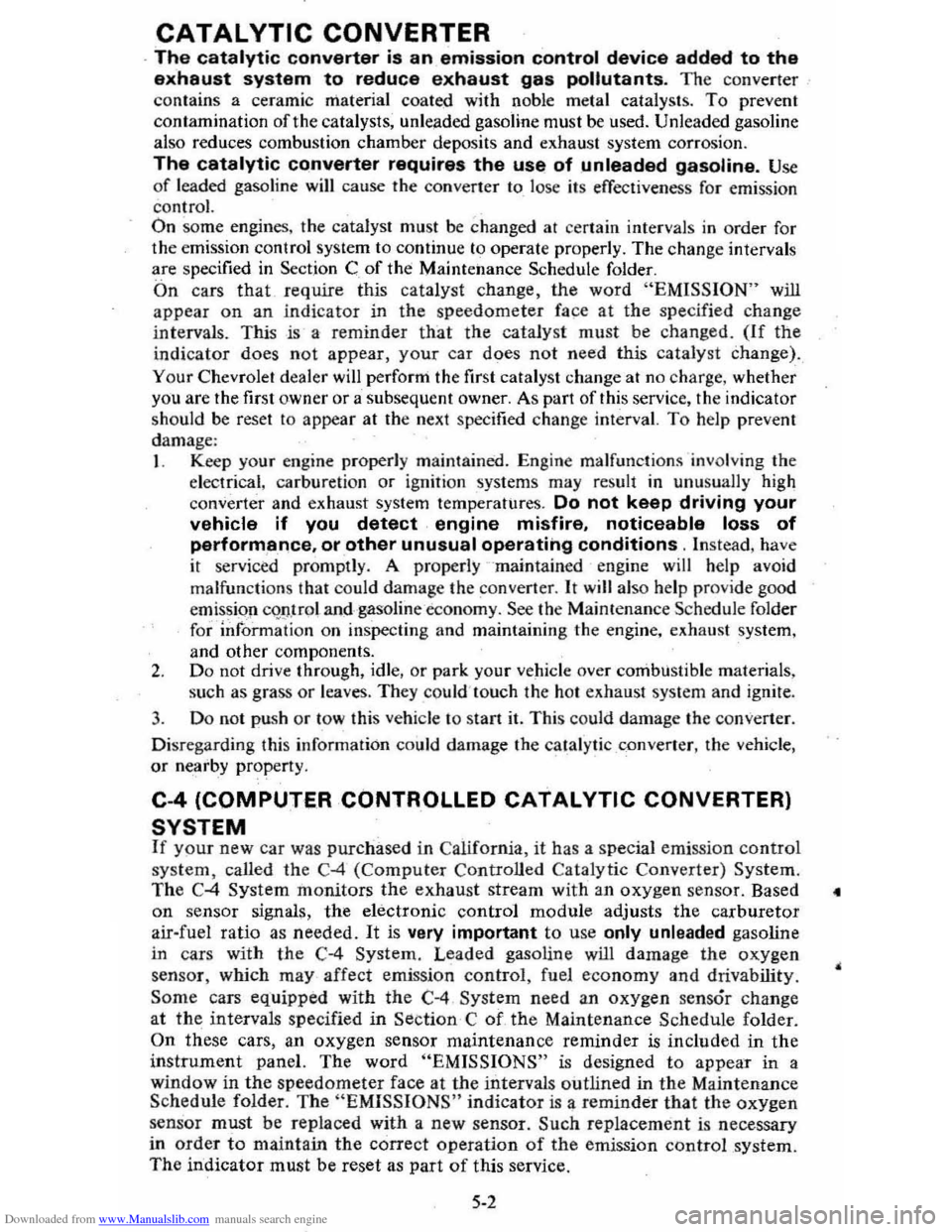
Downloaded from www.Manualslib.com manuals search engine CATALYTIC CONVERTER
. The catalytic converter is an emission control device added to the
exhaust system to reduce exhaust gas pollutants. The converter
contains a ceramic material coated with noble metal catalysts. To prevent
contamination of the cata lysts,
unle~ded gasoline must be used. Unleaded gasoline
also reduc es combustion chamber deposits and exhaust system corrosion.
The catalytic converter requires the use of unleaded gasoline. Use
of leaded gasoline will cause the converter to lose its effectiveness for emission control. On some engines, the catalyst must be changed at cer tain inter vals in orde r for
the emissio n control system to continue to operat e properly. The change intervals
are speci fied in Section C of the Maintenance Schedule folder.
On cars that require this catalyst change, the word "EMISSION" will
appear on an indicator in the speedometer face at the specified change
in terval
s. This is a reminder that the cata lyst must be changed. (If the indicator does not appear, your car does not need this catalyst change).
Your Chevrolet deale r will perform the lirst cataly st cha nge at no charge, whether yO'u are the first owner or a subsequent owner. As part of this service, the indicator
should be reset to appear
at the next specified chang e interval. To help prevent
damage:
1. Keep your engine properly maintained. Engine malfunctions involving th e electrical, carburetion or ignition systems may result in unusually high
conve rter and exhaust system temperatures .
Do not keep driving your vehicle if you detect engine misfire. noticeable loss of
perform,8nce. or other unusual operating conditions. Instead, have it serviced promptly. A properly ···maintained engine will he lp avoid
malfunction s that could damage the converter.
It will also help provide good
emissio.n cq!).,trol and gasoline economy. See the Maintenance Schedule folder
for inform ation on inspecting a
nd maintaining the engi ne. exhaust system.
and other compone nts.
2 .
Do not drive through, idle, or park your vehicle over combustibl e materials,
s u ch as grass
or leaves. They could 'touch the hot exhaust system and ignite.
3. Do n o t push or tow this vehicle 10 stan it. This cou ld damage (he converter.
Disregarding this information could damage the catalytic converter, the vehicle,
or nearby property.
C-4 (COMPUTER CONTROLLED CATALYTIC CONVERTER)
SYSTEM If your new car was purchased in California, it has a special emission control
system, called
the C-4 (Computer Co ntrolled Catalytic Converter) System. The C4 System monitors the exhaust stream with an oxygen sensor. Based 4
on senso r signals, the electr onic control module adjusts the carburetor
air~fuel ratio as needed. It is very important to use only unleaded gasoline
in cars with
the C-4 System. Leaded gasoline will damage the oxygen
sensor. which may affect emission
control, fuel economy and drivability.
Some cars equipped with the C-4 System need an oxygen sensOr change
at the intervals specified in Section C of the Maintenance Schedule folder.
On these cars, an oxyge n sensor maintenance reminder is included in the
instrument paneL The word "EMISSIONS" is designed to appear in a
window in the speedometer face at the intervals outlined in the Maintenance
Schedule folder. The "EMISSIONS " indicator is a reminder that the oxygen
sensor must be repl aced with a new sensor.
Such replacement is necessary
in order to maintain the correct operation of the emiss ion control system.
The indicator must be reset as part of this service.
5-2
Page 64 of 95

Downloaded from www.Manualslib.com manuals search engine On all C-4 cars, a "CHECK ENGINE" light on the instrument panel is
designed to come on during engine starting , to let you know the bulb is working. (The light will stay on a short time after the engine starts.) If the light comes on while driving, service to the emission control system
may be required. See your Chevrolet dealer' as soon as possible for an inspection of the system. Continued driving without having the C-4 System serviced _ could eventually
cause damage
to the emission control system . It could also affect fuel
e conomy and drivabili -ty.
ENGINE OIL AND FILTER RECOMMENDATIONS • Engine oils' are labeled on 'the containers with various API (American
Petroleum Institute) designations 6f quality. Use engine oils that are labeled
5E or SE/CC. Do not use oils labeled only SA, 5B, 5C, SD, CA, CB, CC or CD; _or oils with the combination label SE and CD (SE/CD). Higher
quality oils labeled SF will be introduced soon (late 1979, or 1980). These SF oils are preferred and should be used when available.
• The oil and filter change intervals for your engine are based on the use of SE-quality or SF-quality oils and ,high- quality filters such as AC oil filters. Using oils other than SE-quality or SF-quality oils, or oil change intervals
longer than recommended. could reduce -engine life and might affect your
warranty.
• Your engine was filled with a high·quality engine oil when it was built. You do ,not have to change this oil before the suggested change period.
•
If your normal driving does nQt include one or more of the four "severe service" conditions listed below. change the oil every 7,500 miles (12 000 ' kilometers) or 12 months, whichever comes first. Change the oillilter at the
first oil change. then every second oil change, if mileage (7,500 miles or 12
000. kilom~ters) determines .w ,hen you change the oil. If _time (12 months)
determines when you change the oil, change the filter with every oil change.
• Change the oil and oil filter every 3,000 miles (4 800 kilometers) , or three
months if you often drive under one or more of these 'severe service·,~.
conditions: • Driving in dusty areas
• Towing ,3 trailer
• Frequent idling or idling for long periods
• Driving 4 miles (6 kilometers) br'less in freezing weather,o~other short trips in cold weather, where the engine does not thoTough ,ly warm up.
• Change the oil and oil filter as soon as -possible after driving in a dust
storm.
Oil Viscosity
Engine oil viscosity (thickness) has an effect on fuel economy. Lowec viscosity
engine oils can provide increased , fuel " economy; however, higher temperature
weather conditions require higher viscosity engine oils for satisf~ctory lubrication.
To. get the best fuel economy with your-1980 Chevrolet, -iou should use -,, ' .
fuel. 'saviiJ.&:_engine oil ohhe_ proper viscosity. These oils call_ be found. in serviCe
stations and other retail stores. They are-identified by words such as: "Energy Saving," "Conserves Gasoline," "Gas Saving," "Gasoline Saving," '''Friction
Reducing," "Improved Gasoline Mileage" or "Fuel Saving."
The following chart lists the engine ' oil viscosities recommended for the
temperature range you expect before the next oil change. For lemperalures above ,_18°C (O"F),SAE lOW-30 is -the preferred viscosity grade. Ircold-weather starting
problems
are encountered at temperatures below -lSoC (
oils may be required.
5-3